When I wrote about where to get blog post ideas, I forgot to mention my best source for ideas – my readers! I love hearing from you all and it seems like every time you ask a question, it’s a great idea for a post. Case in point: last week when I wrote about the gallery wall I did for my sister, Julie asked for tips on creating a gallery wall and said she didn’t know where to start. So today, I’ve got some tips on getting started, figuring out how to arrange your wall, and hanging it without making lots of unnecessary holes. Let’s dive in!
Step 1: Look for inspiration and then analyze it.
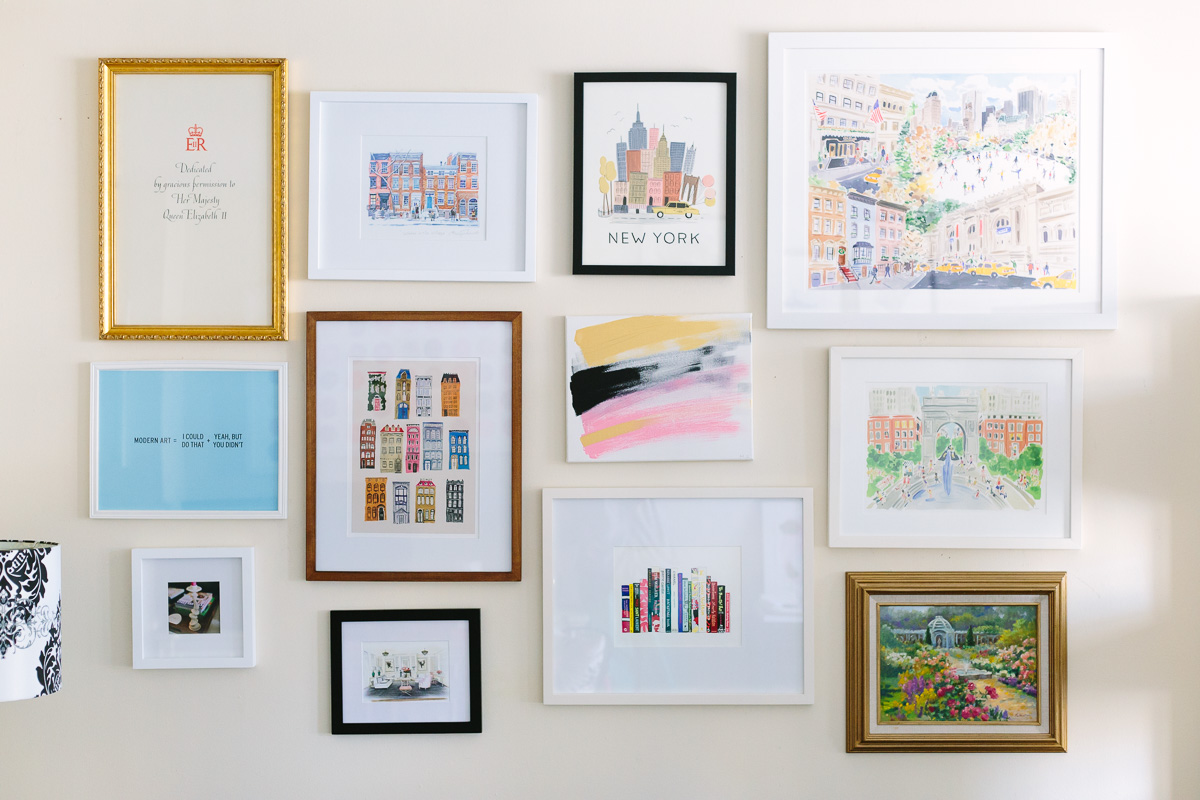
My current gallery wall.
First, look for inspiration. Find gallery walls online that you love and then let’s break it down and figure out why they appeal to you. You’re not going to copy them, you’re going to analyze them in order to understand your taste. So find a few that you like and consider this:
- Are all the frames the same color? The same shape? The same style, or a mix? (modern? Simple? Thick? Ornate?).
- What art pieces are incorporated? Are they all the same (say, all black and white, or all watercolors), or an eclectic mix of photography, paintings, illustrations, etc.?
- Are three-dimensional objects peppered throughout?
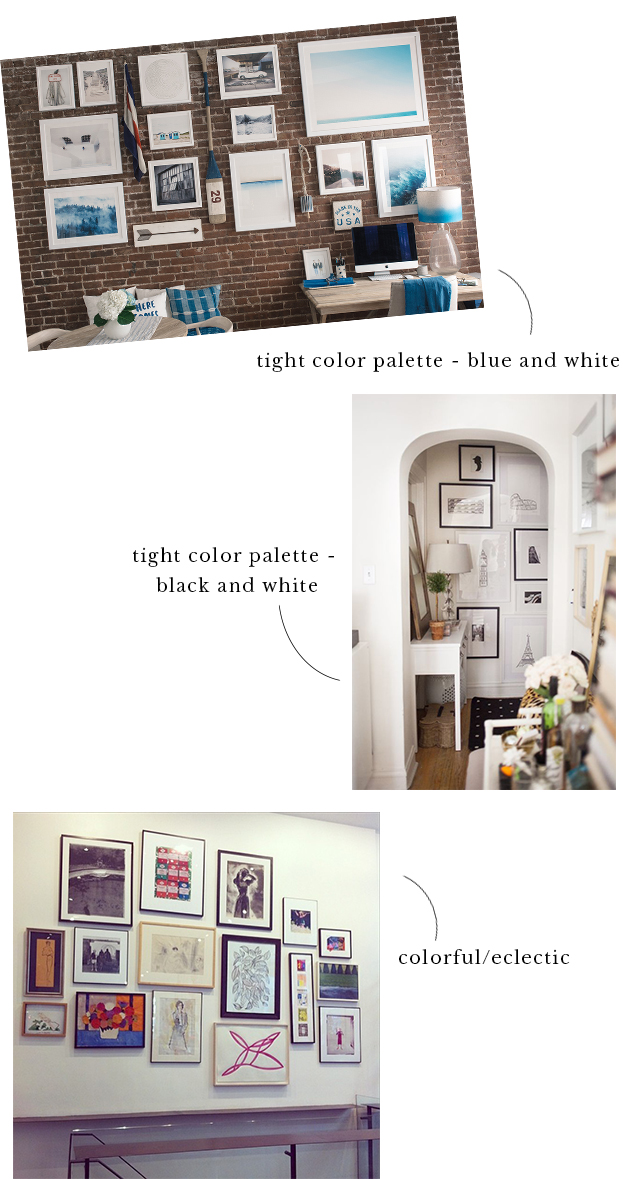
- Are the art pieces all within the same color palette? Or are they eclectic and mismatched?
- Does the art go floor to ceiling, or is there space left around the top and bottom?
- Is the overall look neutral and serene, monochromatic, or colorful and bright?
- How close are the pieces? Does it feel tightly packed and dense, or more light and airy?
- How many pieces are incorporated? Again, tightly packed or light and airy?
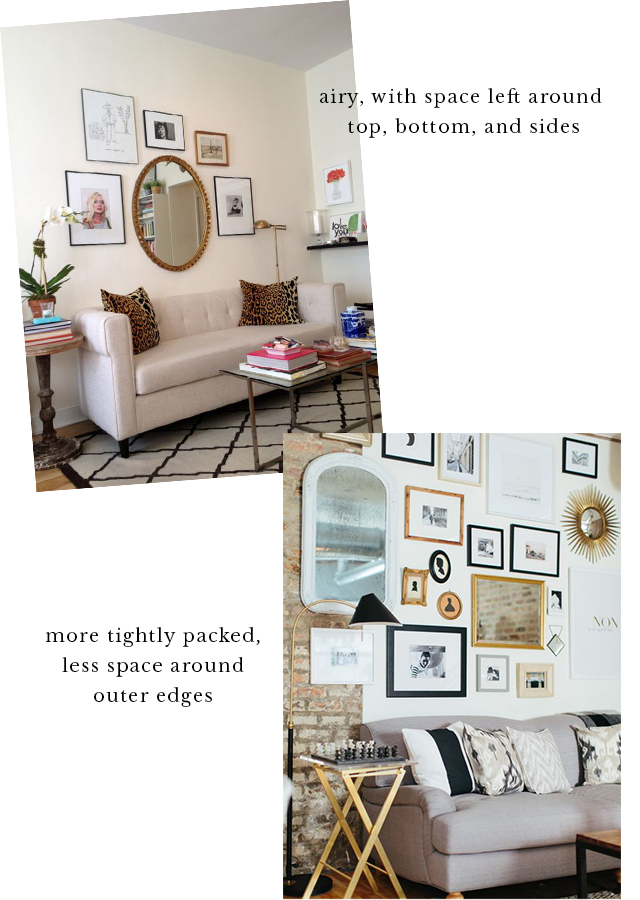
The reason I think you should do this is because all of the above are perfectly acceptable. There are no hard and fast rules to creating a gallery wall, in my opinion – you can make it any which you want and it can look good. So the first step is understanding how you want it to look, then you can go about making it happen. You can also check out my Gallery Walls Pinterest board to see all of my favorites.
Step 2: Hunt and Gather
Once you know how you want your gallery wall to look, you can start gathering your pieces. Where do you start? Inside your own house. This is what I did for my sister’s gallery wall. I had her gather together every piece of framed art she had in her apartment, and I wound up using about half of it. The half I didn’t use were situations where we decided we didn’t like the frame, the art, and/or the mat.
If you find yourself in need of some new art, you can scour flea markets, you can frame old family photos, or you can search online where there are seriously endless options for affordable art. I’ve written about sources for art numerous times, including this post on how to build an easy art collection, plus other posts here, here, here, and here. Recently I’ve been loving the selection at Artfully Walls. Minted is a good option, and there’s always Etsy (especially this shop, wink wink :).
I wrote about affordable framing here and here, and I recommend also checking out Framebridge, Simply Framed, or Framed and Matted. Victoria recently shared her gallery wall using pictures she had framed with Framebridge, and it looks fantastic:
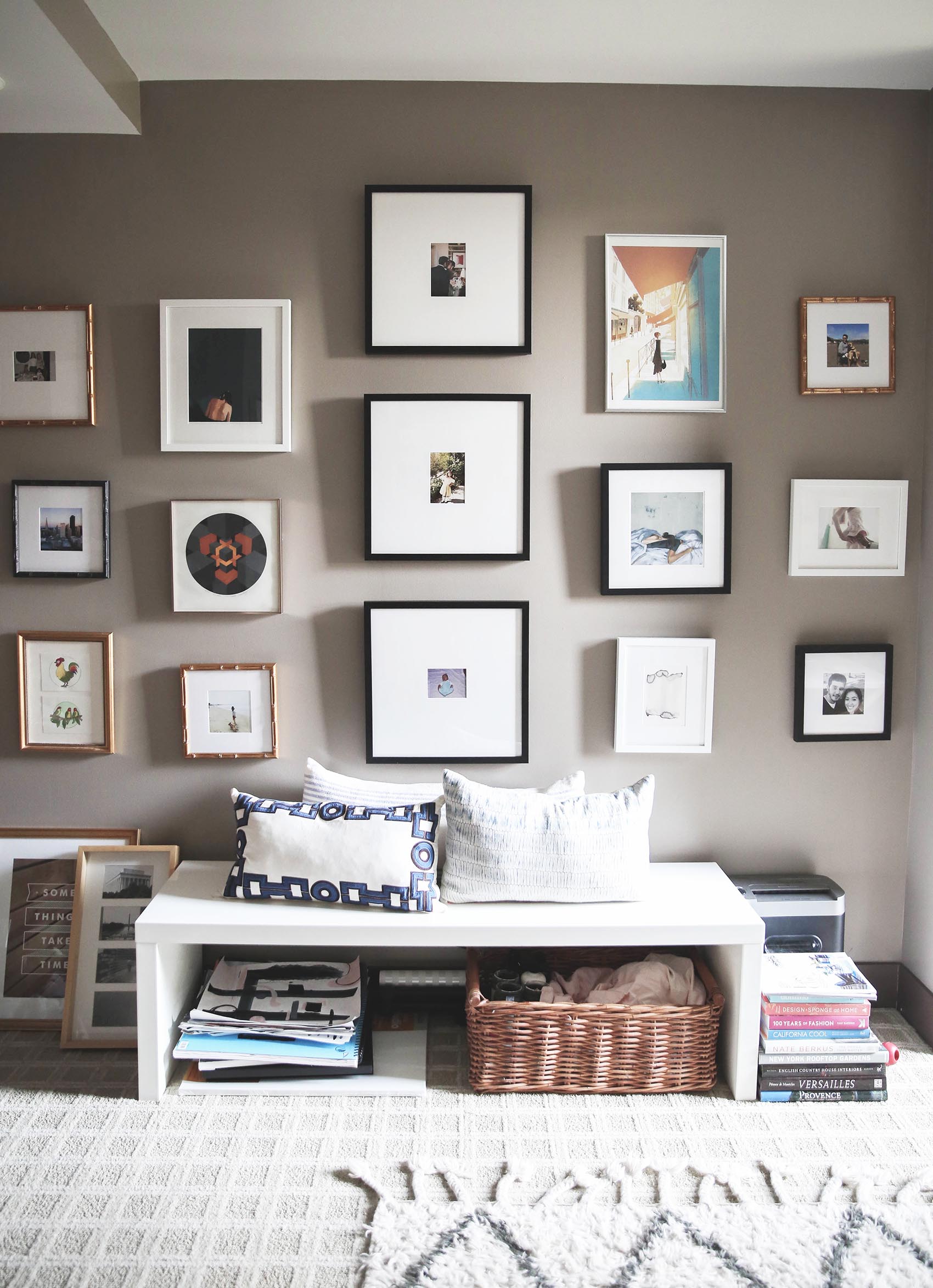
I like how she arranged her pictures in such a unique way – almost like a loose grid.
Emily Henderson did a comprehensive round-up of pretty much every frame under the sun that fits standard-sized pictures, so that’s certainly worth checking out if you need frames.
There are a few ways of figuring out how many pieces of art you actually need for your space. You can measure the wall and then measure your pieces and get sort of math-y about it. I’m really more of a visual person so I usually eyeball it. In the case of my sister’s gallery wall, the space I was filling above her couch was pretty similar to the space I did above my own couch, so I went back to an old blog post to see how many pieces I had incorporated into my own gallery wall. It turned out it was roughly double the amount of pieces I had for my sister’s wall! Uh-oh. But instead of saying, well can’t do it, need to get more art, I decided to, in the words of Tim Gunn, make it work. I pulled in a piece that had previously been in the discard pile for no particular reason and increased the spacing a bit between all of the pieces, and with a little finagling, it worked out. So if you find yourself without quite enough art, before you give up and go looking for more and spending more money, see if you can just move things around and make it work.
Consider whether you want to incorporate some three-dimensional objects, mirrors, or other eclectic items into your gallery wall. See what you have and really love – think creatively! A round item (whether it be a mirror, a round-framed picture, a starburst, or some other decorative object), can help break up all the squares and add an interesting visual dimension.
Step 3: Make Cutouts
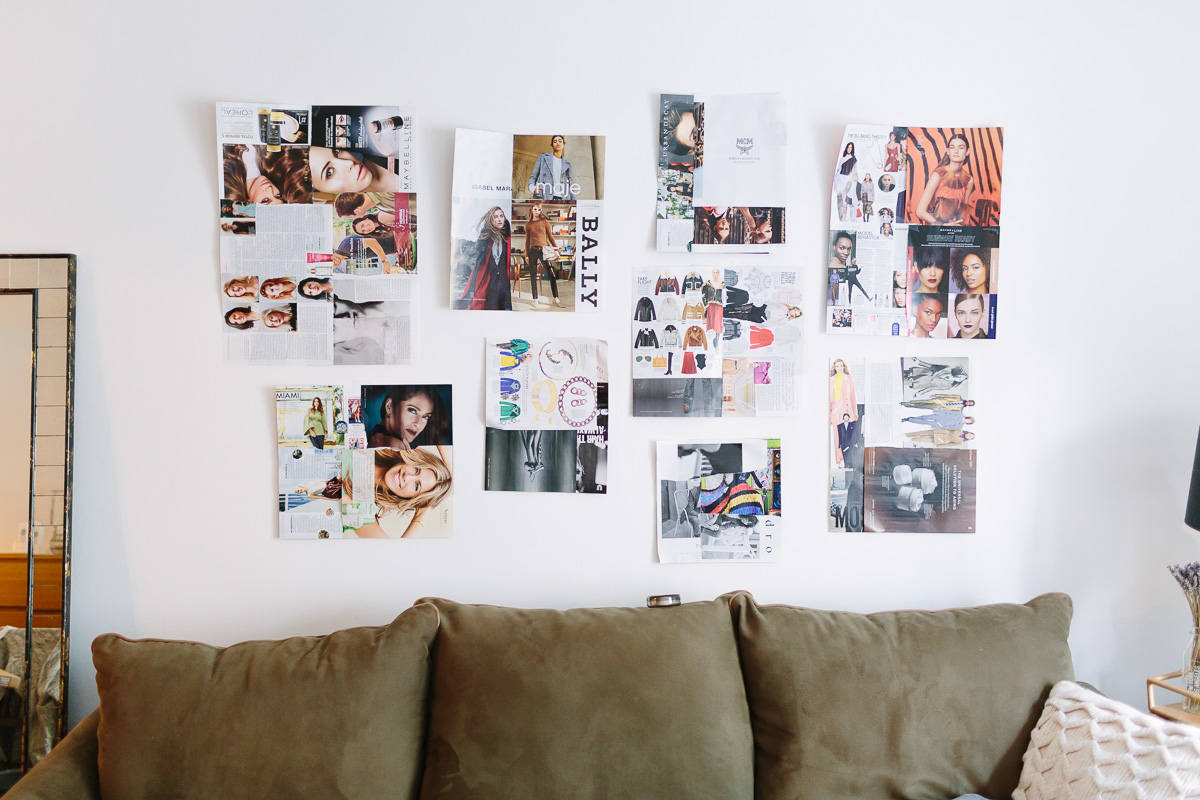
Again, you can go about this in many different ways. I like to arrange my art pieces on the floor just to get a rough idea of where I want each piece to go and how they relate to each other. Then I make a paper cutout of each piece, by taping together pieces of paper until they are the same size and shape as an art piece. Then, I take that and tape it on the wall, for all of the pieces. This way I can “see” the “art” on the wall without making any un-needed holes. Then I move the cutouts around and around (and around, and around), until I like the arrangement. Pro tip: on your cutout, mark exactly where the little hook is on the back of the picture – that way you know exactly where to put your nail. You can even just hammer right through the cutout, and voila.
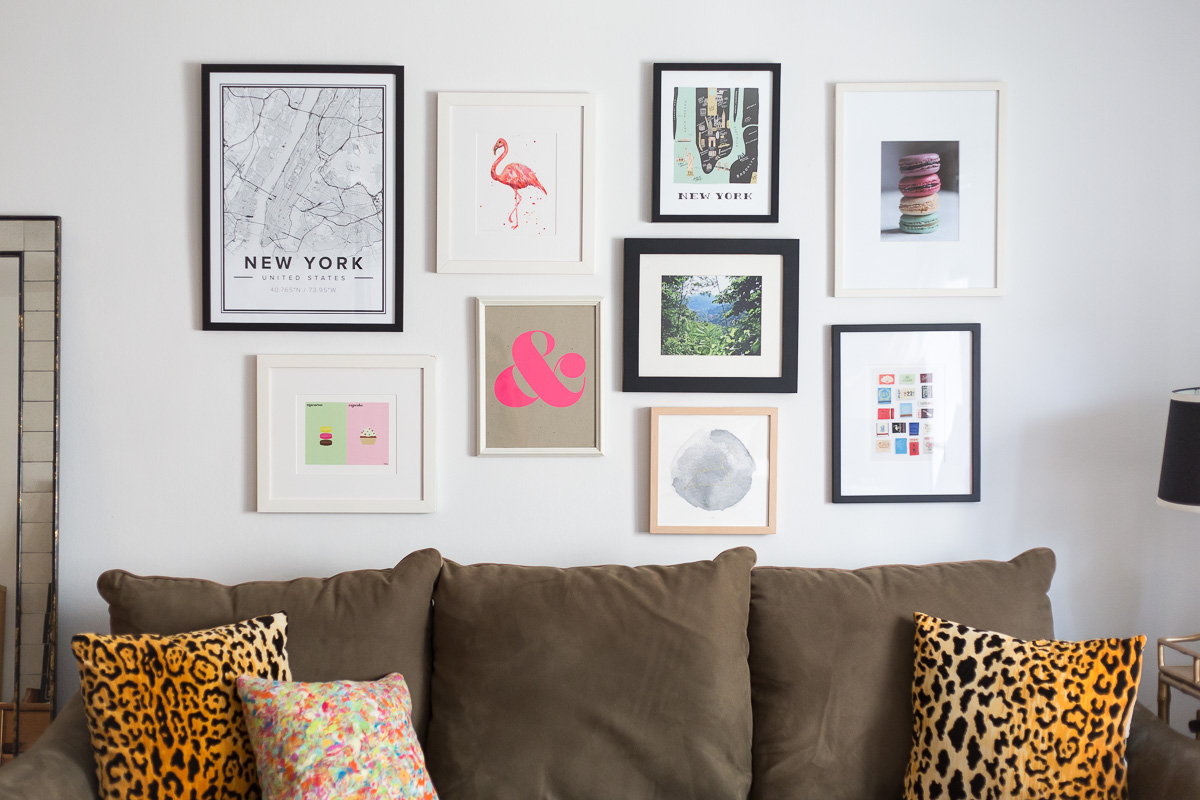
Step 4: How to Arrange
So, again, this is all about what looks right to your eye. I usually start with my biggest piece and put it in the left corner. I don’t know why, that’s just what looks right to my eye. Then I work from there. You want to start with an anchor piece (your biggest piece), and decide where you want that, then work from there. Usually when I do gallery walls they wind up looking like two straight lines going across, which I don’t really like – it’s just always what happens. When it does, I’ll then move things around to make it look more staggered. The other thing I usually do is hang a piece of equal visual weight (shape + size) on the top right corner, to balance out the piece on the left. I like it to look sort of random and eclectic, but also balanced.
Another consideration: I prefer gallery walls where the overall shape of the full art wall is a square, not a rectangle. Pure personal preference. Think about which you prefer:
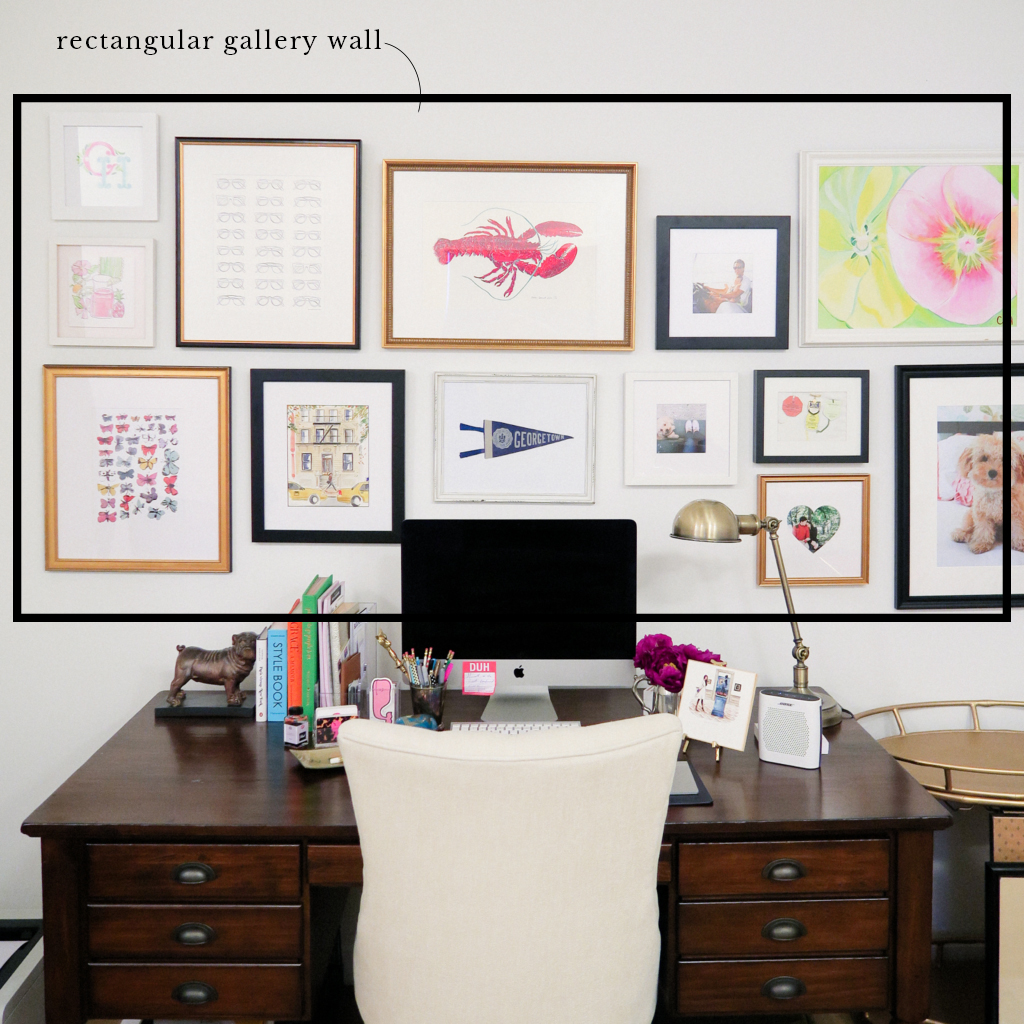
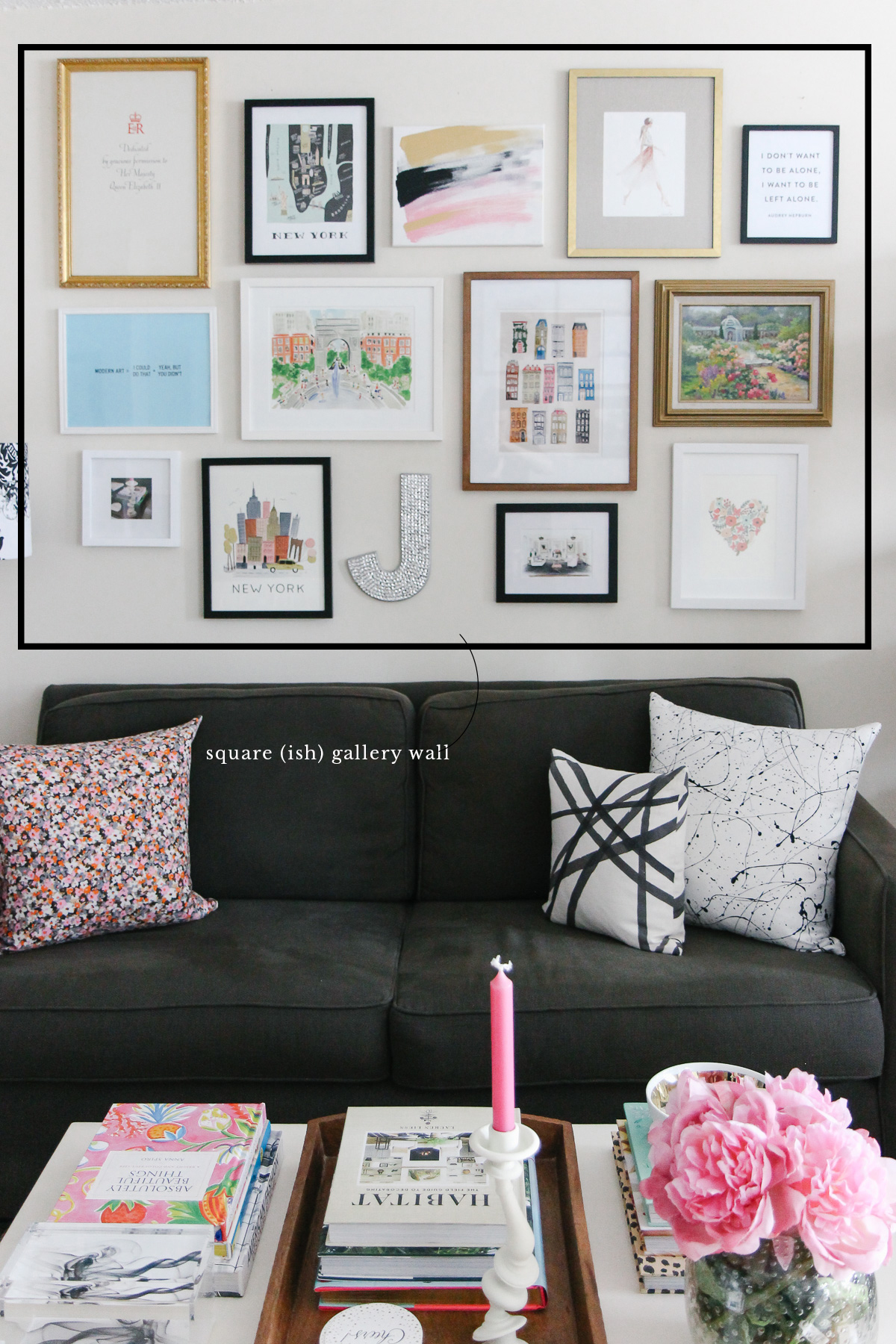
Step 5: Hang It Up!
The last step is to go ahead and hang your gallery wall! As I mentioned in last week’s post about my sister’s gallery wall, I couldn’t get nails to hammer into her wall so I used 3M command strips. Both are good options.
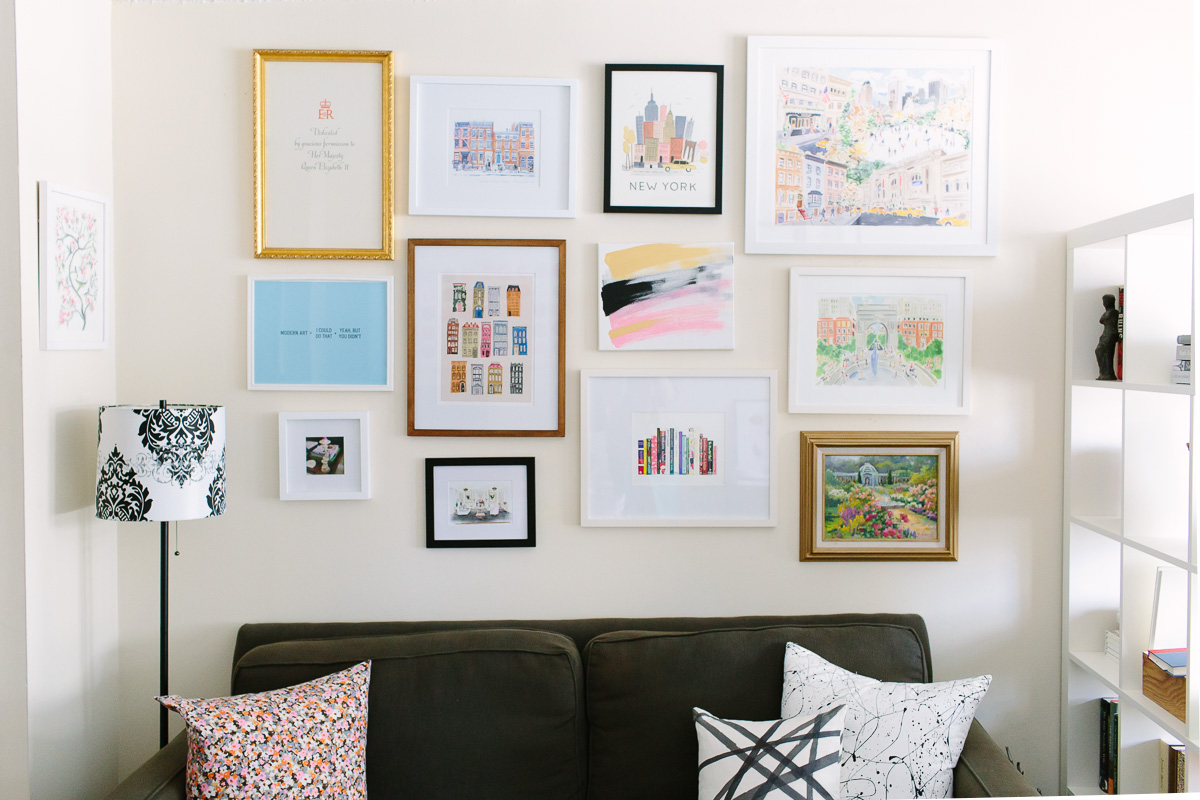
Any questions, let me know in the comments!
image sources: blue and white gallery wall // black and white gallery wall // airy gallery wall // compact gallery wall // Victoria’s gallery wall // rectangular gallery wall // all other images by Jacqueline Clair
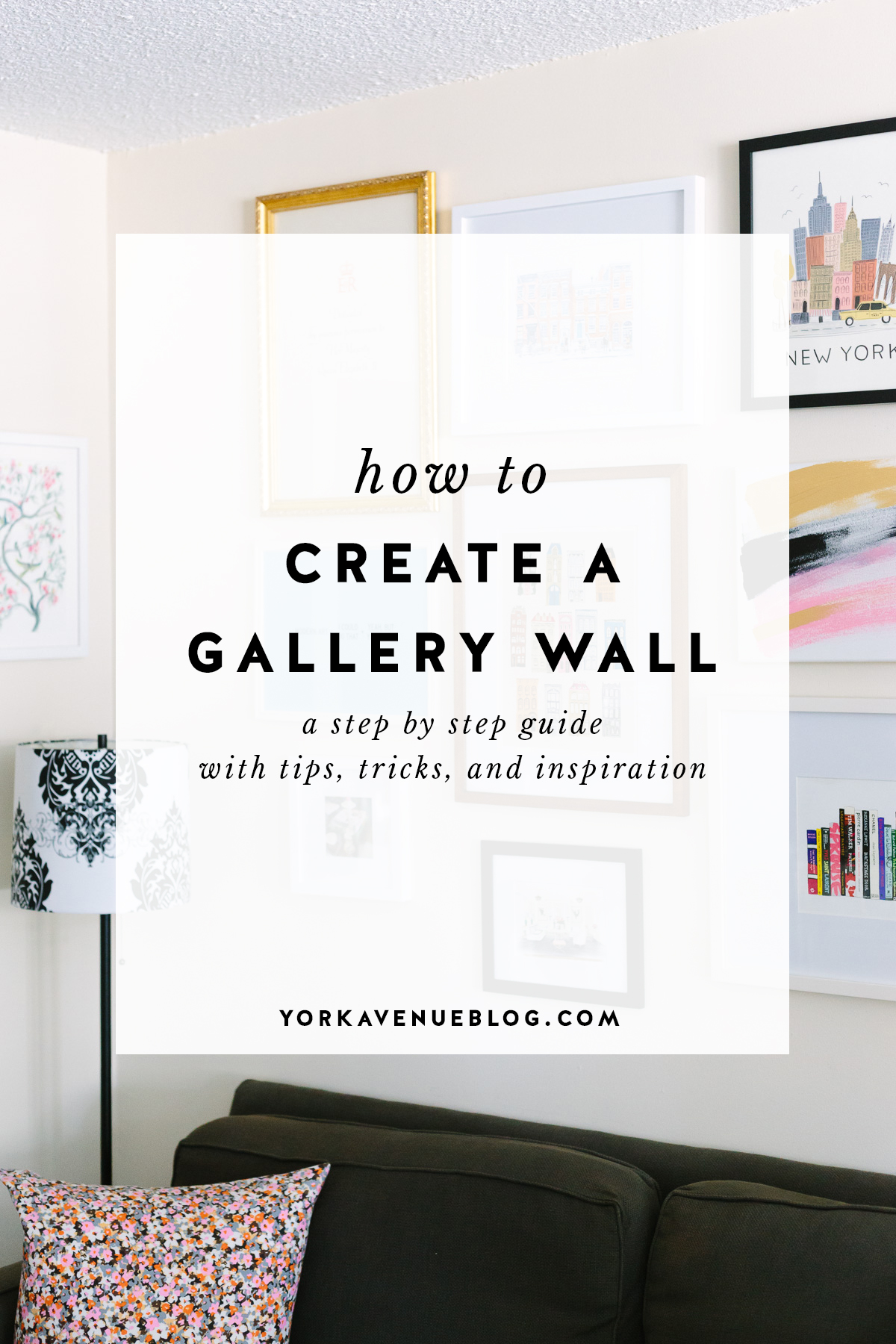
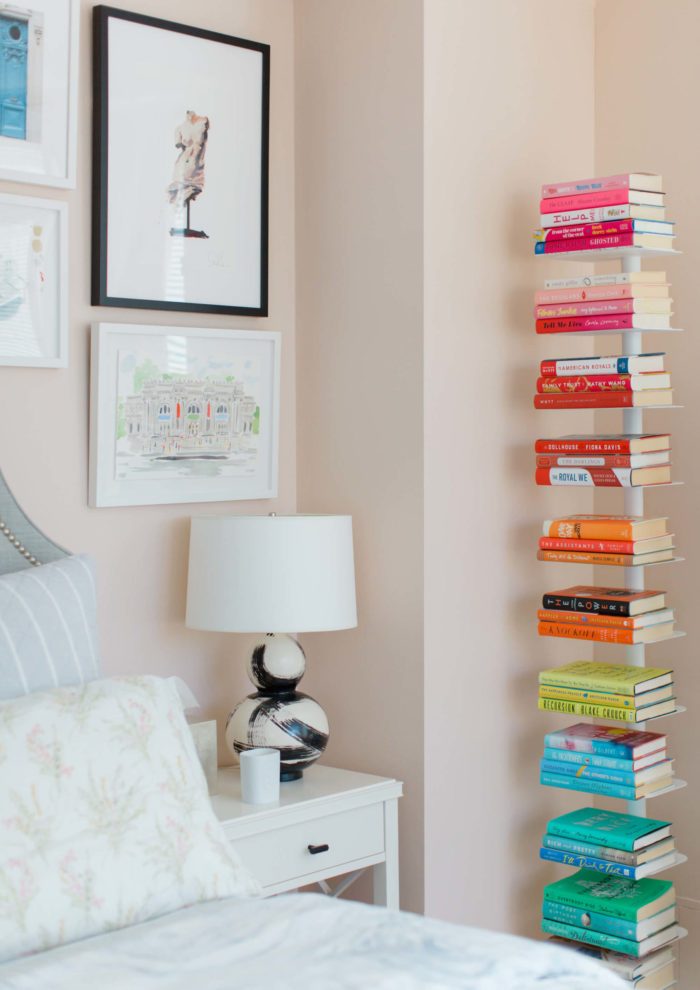
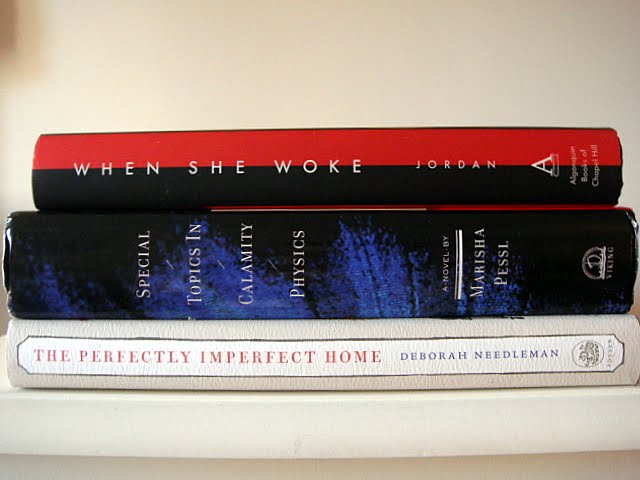

Thanks for including my gallery wall!! I prefer square too…. but that wall with my desk is SO BIG!!
I think it’s important to consider the space too…like a square wouldn’t have worked above your desk I don’t think. Rectangle makes more sense there and it looks great!
The idea to make paper cutouts is going to save me so much time. I have a bunch of framed photos and prints waiting to be hung and I wasn’t sure how to put them up without my last few pieces ready. Now I’m realizing I can just make cutouts of them since I know what size they’re going to be and get to work today. Thanks for the tips!
Yay so happy to hear that! It’s the best strategy I’ve come across. Good luck with your gallery wall!
Thank you for including a picture from my most recent gallery wall. Love this round up and all of your tips. I like a square or rectangular gallery wall best, not so fond of irregular styles. Too Type A, I guess! 😉
I think I’m the same! All about those squares 🙂
I love the look of gallery walls. I’ve been wanting to do one in my hallway but just haven’t gotten around to it yet. These are great tips and when I’m ready to do it, I’m definitely coming back to this post!
Awesome, so glad!